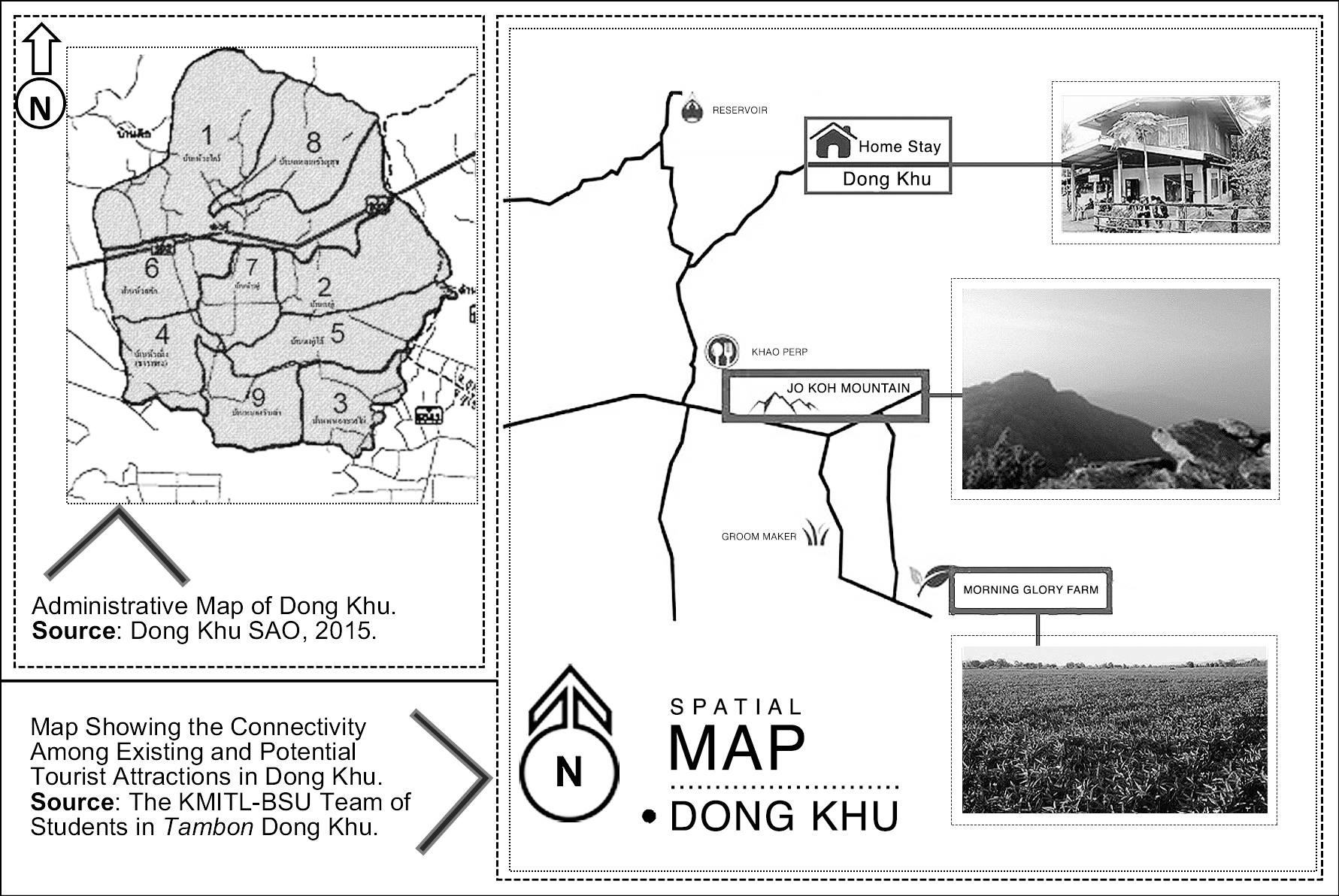The Pedagogical Efficacy of Learning from the Built Environment through Real-life Experiences: A Case Study from Communities around Si Satchanalai Historical Park
Main Article Content
Abstract
In early 2017, a combined team of faculty members and students from King Mongkut’s Institute of Technology, Ladkrabang (KMITL) and Ball State University (BSU), U.S.A., conducted a three-week field study in three neighborhoods around Si Satchanalai Historical Park, one of UNESCO World Heritage sites in Thailand. Drawing on the concepts of Coordination, Cooperation, and Collaboration (3Cs), the Thai and foreign students jointly created several spatial maps to record their encounters with the livelihood—along with artistic and architectural heritages, as well as social and cultural practices—in Nong O, Sarachit, and Dong Khu sub-districts in Sukhothai province.
The abovementioned activities supplied the contextual basis for this research to assess the pedagogical efficacy of learning from real-life experiences via the spatial mapping projects in those communities. Informed by Bloom’s taxonomies of learning, the upcoming evaluative discussions contained a series of independent sample t-tests, utilizing a number of questionnaires and surveys for collecting data to construct a content model in terms of comparative studies between the KMITL and BSU members.
In effect, the statistical inquiries disclosed that not only did the participants advance their cross-cultural interactions and understanding with each other, but also gained a higher body of knowledge apart from developing many crucial skills, such as critical and creative thinking capabilities. The qualitative investigations further exhibited that the 2017 KMITL-BSU fieldwork contributed several scholarly improvements, resulting in academic achievements by the partakers from both universities.
Downloads
Article Details

This work is licensed under a Creative Commons Attribution-NonCommercial-NoDerivatives 4.0 International License.
All material is licensed under the terms of the Creative Commons Attribution 4.0 International (CC-BY-NC-ND 4.0) License, unless otherwise stated. As such, authors are free to share, copy, and redistribute the material in any medium or format. The authors must give appropriate credit, provide a link to the license, and indicate if changes were made. The authors may do so in any reasonable manner, but not in any way that suggests the licensor endorses you or your use. The authors may not use the material for commercial purposes. If the authors remix, transform, or build upon the material, they may not distribute the modified material, unless permission is obtained from JARS. Final, accepted versions of the paper may be posted on third party repositories, provided appropriate acknowledgement to the original source is clearly noted.
References
Amphoe Si Satchanalai. (2010). Baan Sarachit. Villages in Si Satchanalai. Retrieved February 26, 2017, from http://sisatchanalai.com/หมู่บ้านในศรีสัชนาลัย/บ้านสารจิตร/.
Askland, H., Awad, R., Chambers, J., & Chapman, M. (2014). Anthropological quests in architecture: Pursuing the human subject. International Journal of Architectural Research, 8(3), 284-295.
Barnes, B. (2017). Bloom’s taxonomy of the cognitive domain. The complete encyclopedia of skiing—EpicSki skiing glossary. Retrieved April 23, 2017, from http://www.epicski.com/a/the-complete-encyclopedia-of-skiing-epicski-skiing-glossary.
Ben-Zaken, A. (2010). From ‘Incommensurability of cultures’ to mutually embraced zones. In Ben-Zaken, A. (Ed.), Cross-cultural scientific exchanges in the eastern mediterranean 1560-1660. Baltimore: Johns Hopkins University Press.
Bloom, B. S. (1956). Taxonomy of educational objectives, Handbook I: The cognitive somain. New York: Longman.
Bozdogan, S. (1999). Architectural history in professional education: Reflections on postcolonial challenges to the modern survey. Journal of Architectural Education, 52(4), 207-215.
Cronbach, L. J. (1951). Coefficient alpha and the internal structure of tests. Psychometrika, 16, 297-334.
Designated Areas for Sustainable Tourism Administration (DASTA). (2014). Baan Cook Pattana: Kite makers recounting Phra Ruang stories (Baan Cook Pattana: Khontamwao Laotamnan Phraruang). Retrieved December 3, 2017, from http://agrotourism.doae.go.th/data/dasta/บ้านคุกพัฒนา%20จ.สุโขทัย.pdf.
Djamarah, S. B. (1994). Learning achievements and master competencies. Surabaya: National Business.Halse, J. (2008). Design anthropology: Borderland experiments with participation, performance and situated intervention. (Doctoral dissertation: IT University of Copenhagen). Retrieved February 16, 2017, from, http://nordicom.statsbiblioteket.dk/ncom/en/publications/design-anthropology%284bc96110-526b-11dd-b542000ea68e967b%29.html.
Jarzombek, M. (1999). A prolegomenon to critical historiography. Journal of Architectural Education, 52(4), 197-206.
Kagan, S. (1994). Cooperative learning. San Clemente, CA: Resources for Teachers.
Kagan, S. (2009). Kagan cooperative learning. San Clemente, CA: Kagan Publishing.
Kagan, S., & Kagan, M. (1998). Multiple intelligences: The complete MI book. San Clemente, CA: Resources for Teachers.
King Lithai. (1985). Traibhumikatha (The story of the three planes of existence). Bangkok: ASEAN Committee on Culture and Information.
Lefebvre, H. (1991). The production of space. Oxford: Basil Blackwell.
Noobanjong, K., & Louhapensang, C. (2015). Bridging the horizon: A collaborative and cooperative approach for cross-cultural learning on the artistic and architectural heritages of central and northern Thailand. Journal of Architectural/Planning Research and Studies, 12(1), 103 - 122.
O’Brien, D., & Natakun, B. (2016). Bower 08 sala revisited: Lessons for community-based live projects. Journal of Architectural/Planning Research and Studies, 13(1), 75 - 90.
O’Reilly, K. (2009). Ethnography. London, Thousand Oaks, New Delhi, Singapore: Sage Publications.
Pavlides, E., & Cranz, C. (2012). Ethnographic methods in support of architectural practice. In S. Mallory-Hill, W. Preiser, & C. Watson (Eds.), Enhancing building and environmental performance. Hoboken: John Wiley & Sons, Inc.
Pieris, A. (2014). Beyond Southeast Asia: Repositioning national and regional identities through architectural discourse. Paper presented at the 1st Southeast Asia architecture research collaborative symposium, National University of Singapore, January 8-10, Singapore.
Rockwood, H. S. III. (1995a). Cooperative and collaborative learning. The National Teaching and Learning Forum, 4(6), 8-9.
Rockwood, H. S. III. (1995b). Cooperative and collaborative learning. The National Teaching and Learning, Forum 5(1), 8-10.
Sukhothai Provincial Administration. (2007). Concise factual information on Sukhothai Province [Banyaysarup Changwat Sukhothai]. Retrieved February 22, 2017, from: http://www.sukhothai.go.th/3584/data/present_2550.pdf.
Suri, J. F. (2011). Poetic observation: What designers make of what they. In A. J. Clarke (Ed.), Design anthropology. Object culture in the 21st century. Wien, New York: Springer.


